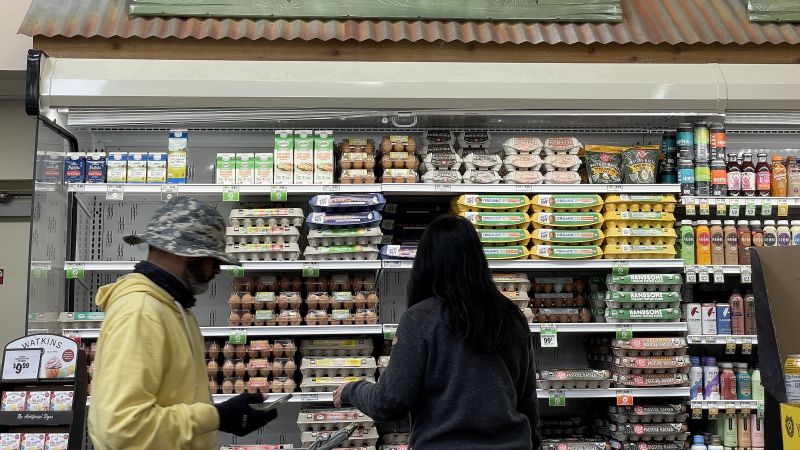

A version of this story first appeared in CNN Business’ Before the Bell newsletter. Not a subscriber? You can sign up right here. You can listen to an audio version of the newsletter by clicking the same link.
Washington DC
CNN
—
After more than a year of soaring prices monopolizing the attention of Wall Street, Main Street, economists, and journalists, the tide may be turning.
According to some experts, inflation rates have reached an inflection point and painful interest rate hikes could soon ease.
The US Consumer Price Index, a widely used measure of inflation, has shown a significant deceleration since it shot up by 9% in June 2022. As of now, CPI inflation stands at 5%, the lowest it has been since May 2021.
Some economists believe that this level — around 5% — is the point at which inflation is no longer considered an emergency issue. That means the Federal Reserve could feel less pressure to quickly stabilize prices through aggressive, economically painful interest rate hikes.
“Once inflation gets down below 5%. It disappears from the headlines,” Johns Hopkins economist and central bank scholar Laurence Ball told Before the Bell last month. “People go back to worrying about budget deficits or climate change or other public issues there are.”
The 5% idea dates back at least to the 1980s when former Federal Reserve vice chairman Stanley Fischer identified the threshold number as the point where inflation dropped way down the rankings of the nation’s problems.
While the Federal Reserve maintains a target inflation rate of 2%, said Ball, “I can imagine that a few years from now, inflation could still be at 3 or 4% and it won’t be a front burner issue.”
Barry Ritholtz of Ritholtz Wealth Management echoed that sentiment on Wednesday. “A 5 handle is a huge development,” he wrote.
Other economists have backed the idea: A recent study by the economics department at the University of Massachusetts Amherst found that there was no significant economic pullback with inflation targets around 5%.
“Our findings suggest that it is not typically necessary to force down inflation to such low levels, especially given that contractionary monetary policies succeed in controlling inflation primarily through the channel of raising mass unemployment and weakening workers’ bargaining power,” they wrote.
“The Fed … will insist that their job is done when inflation hits 2%,” Ball told Before the Bell on Wednesday. But if inflation floats above that target while remaining relatively low, “that’s a situation where a lot of people, including me, are doubtful that the Fed will really act on what it’s saying,” he added.
It’s not necessarily a bad number for the stock market, either. An analysis of stock performance by BlackRock dating back to 1920 found that as long as inflation doesn’t cross 10%, equities continue to perform relatively well. Between 1966 and 1999, nominal annual returns averaged 12.3% against an average 5% annual inflation rate.
Still, there’s a 67% chance that the Fed will raise rates by a quarter percentage point at its next meeting in May, according to the CME FedWatch Tool.
The broader US banking system remains sound and stable, but the two regional banks that failed were “poorly managed” and “took unacceptable risks,” White House economic adviser Lael Brainard told CNN’s Poppy Harlow in an interview Wednesday at Semafor’s World Economy Summit in Washington, DC.
Last month’s collapse of Silicon Valley Bank and Signature Bank roiled markets and spread fear through the economy of a possible wider banking crisis.
The US Treasury, Federal Reserve and Federal Deposit Insurance Corporation all intervened to ensure bank customers could access all their money and to attempt to stave off future bank runs.
“The banking system, it’s very sound, it’s stable; the core of the banking system has a great deal of capital that was put in place in the wake of the 2008-2009 global financial crisis,” said Brainard, director of the White House National Economic Council. “There were some banks who were not managing their risks effectively. They failed, and the president took strong actions along with the Secretary of the Treasury and the banking regulators,” she said.
“Those actions reassured Americans their deposits are safe, the banking system is sound; but it was also important to the president that the executives of those failed banks were held accountable and, very important, that taxpayer money not be at risk,” she continued.
Klaas Knot, chair of the Financial Stability Board, a body of global regulators and government officials, wrote in a letter released Wednesday that — unlike other recent shocks to financial markets — crises at US regional banks and Credit Suisse
(CS) in March originated from “within the financial system.”
Later on Wednesday, Andrew Bailey, governor of the Bank of England, said that regulators could now place stricter liquidity requirements on lenders.
So what does that mean? My colleague Anna Cooban reports: Banks could be told to hold more assets that can be easily converted into cash to pay back creditors in times of crisis.
